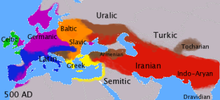The origin and spreading out of the Celtic peoples is a topic shrouded in mystery, at least to my mind. While the Germanic migrations occurred during the late Imperial Roman period and Early Middle Ages, the Celtic migrations generally occurred much earlier, as there is historical evidence of the Gaels existing in Ireland since at least 500 B.C.
The Brythonic Celts, as opposed to the Gaelic (or Goedelic) Celts, have a somewhat better-known history, at least in the sense that we know well that they inhabited the lands of Ancient Britannia (specifically England, Wales, and southern Scotland) and later Brittany in modern France (following the Anglo-Saxon invasions of England). Geographically, this is a fairly localised region, and well documented thanks to Roman sources.
A few facts we do know about the ancient Gaelic peoples:
They are a branch of the Celts, who ultimately are thought to originate with the Hallstatt culture in central Europe (Austria/Czech Republic/southern Poland/southern Germany), cerca 1500-1000 B.C.
Ancient Celtic peoples are documented to have settled in Gallaetia in Anatolia (by the Greeks), Bohemia (named after the Boii tribe), northern Italy (mentioned in the histories of the Roman Republic), most of modern France, Belgium, and parts of ancient Hispania.
The branching of the Celtic peoples into the Brythonic category and Gaelic category is based on well-studied linguistic principles, suggesting a major split in populations at one time.
Of these ancient regions, Gaul, Ireland, and Gallicia (as well as other regions of nothern Spain) were well-known Gaelic regions. The lesser-known Gallicia on the Polish/Ukraine border was also named after the Celtic tribes that once resided there.
The Gaelic folk of modern Scotland are known to descend from the Galiec immigrants from Ireland, who in the 5th (?) century A.D. founded the kingdom of Dal Raetia in western Scotland and the Hebrides. They displaced many of the original Brythonic/Pictish peoples, eventually assimilating along with the later arrivals of the Angles and Norsemen.
So my related questions are:
What was the documented first mention of Celtic (Gaelic) inhabitants in Ireland?
Where did the Gaelic inhabitants of Ireland, Gaul, and northern Spain come from? Was it a mutually common source or did one act as the progenitor of others?
Are there any well documented sources about the proto-Gaelic people (opposed to the more generic proto-Celtic people); their language/culture/location?
Additionally, if anyone has information on any Celtic subgroups that fall outside of the common Gaelic/Brythonic divisions (for example the Anatolian Celts?), I would be most interested to hear of such.




